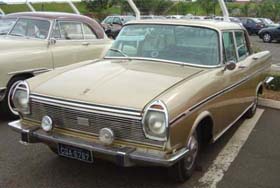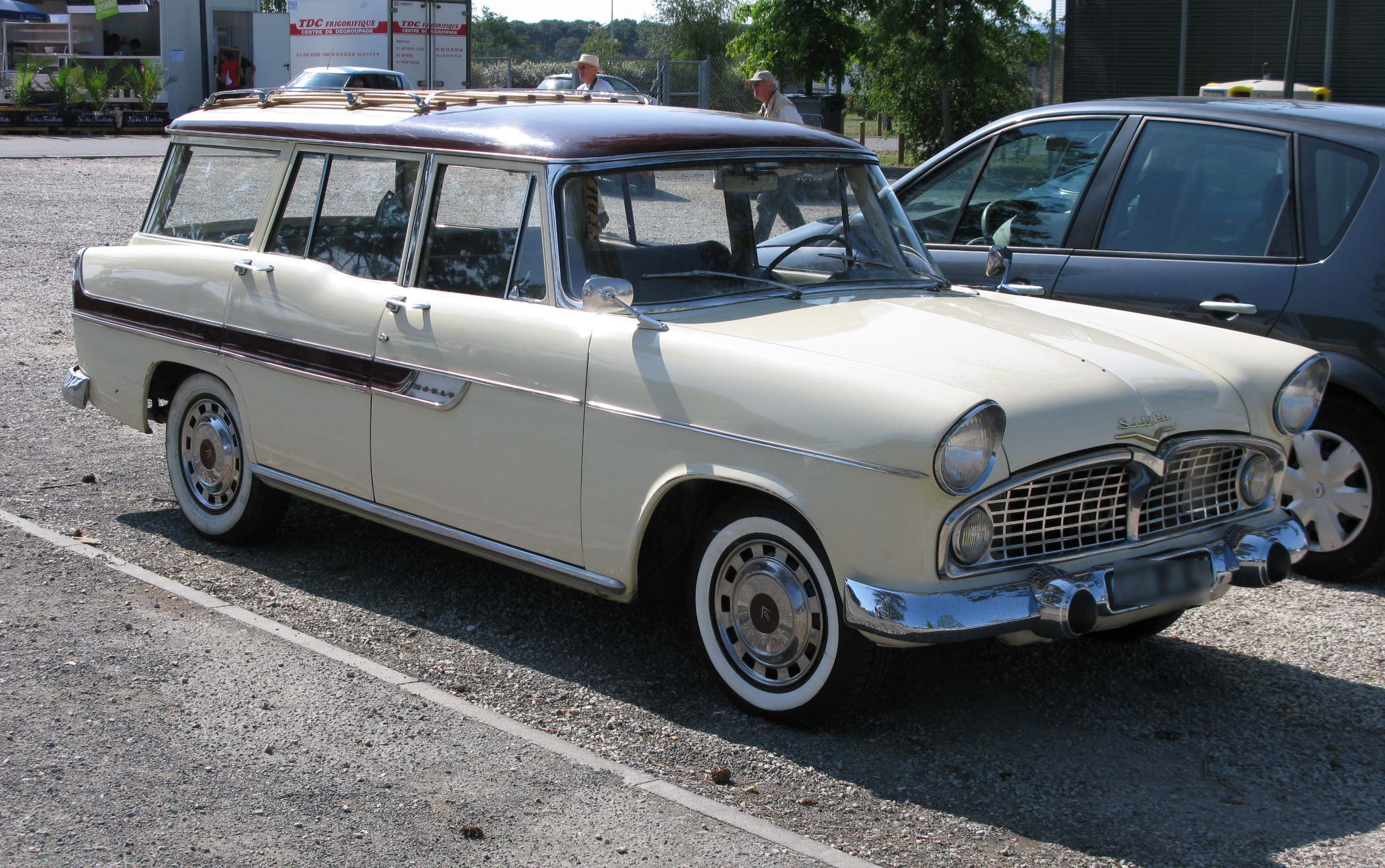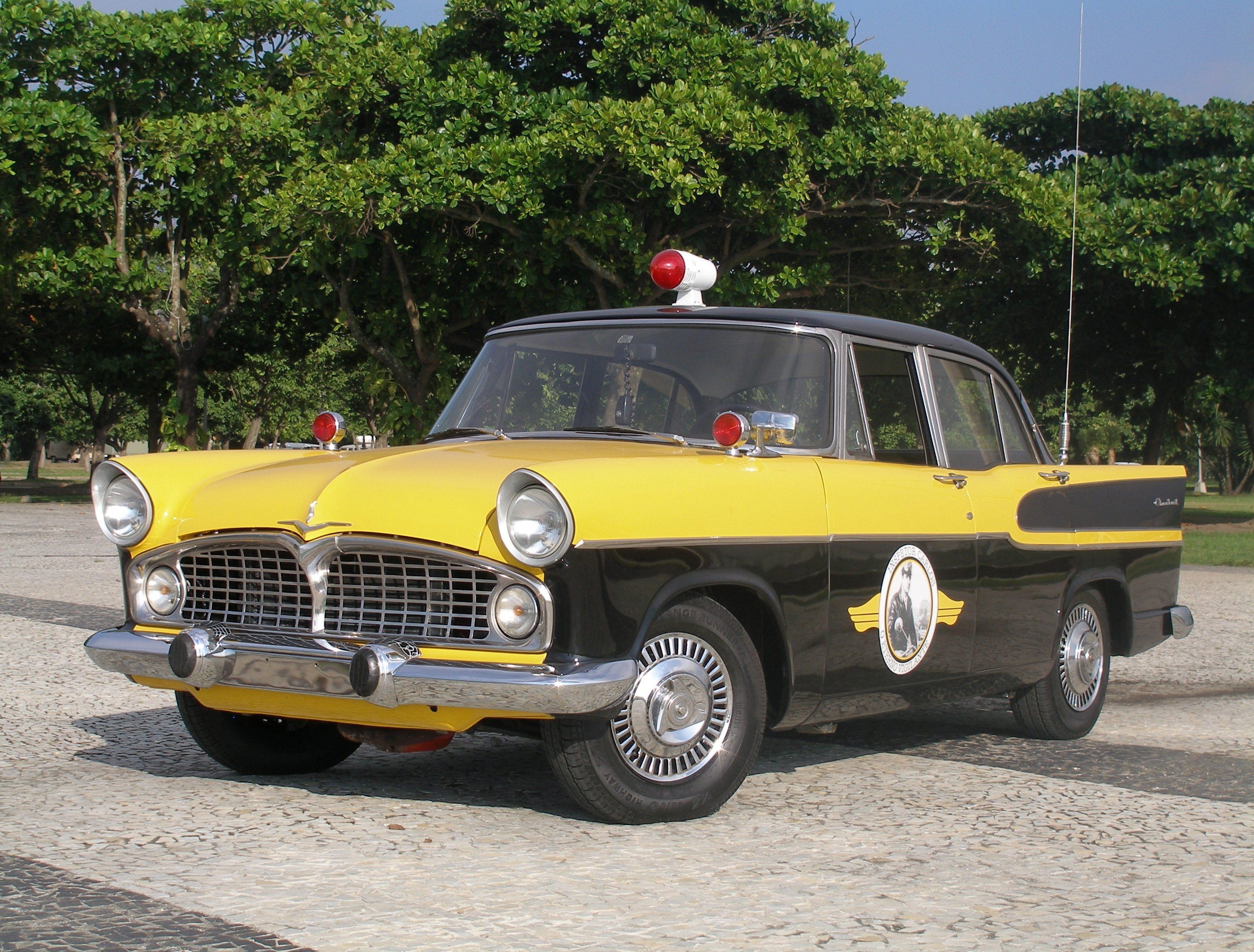|
Simca Chambord (Brazilian Model)
The Simca Chambord is a car built by Simca do Brasil, a subsidiary of the French automobile manufacturer Simca. Based on the Simca Vedette, the first Brazilian Chambord left the production line in March 1959. It featured a standard V8 engine, a 3-speed gearbox with the shifter located on the steering column, and was assembled from parts imported from France. Related models included the Simca Présidence, Simca Rallye, Simca Jangada (a station wagon based on the Simca Marly), Simca Alvorada, and Simca Profissional. Throughout 1960 Simca do Brasil gradually introduced parts produced by local OEM parts suppliers. In 1961, the Chambord received an improved engine with and 15% more torque, a slightly shorter differential. 98% of the parts were of Brazilian production. A special version, called the Tufão (whirlwind) featured some additional luxury items in its interior. 42,910 units of the Chambord were built up to 1966, and the engine performance gradually rose to . These m ... [...More Info...] [...Related Items...] OR: [Wikipedia] [Google] [Baidu] |
Simca Do Brasil
Simca do Brasil was a subsidiary of the now defunct French automaker Simca and started out in the late 1950s assembling the Simca Vedette imported in kit form from France and selling it in three versions, the Chambord, Présidence and Rallye. Later the Company manufactured the radically restyled Esplanada with improved engines and, with increasing control by the Chrysler Group over the French concern, was taken over by the American car giant as majority share holder. During its ten years of market presence Simca defended its market share against fierce competition from Volkswagen, Ford, Chevrolet and Willys. The brand disappeared from the Brazilian Market in the late 1960s following a strategic decision by its owners Chrysler. Foundation The Simca plant received a visit by Juscelino Kubitschek before his inauguration as president in 1956, organized by a Brazilian General who had a family member employed in Poissy. Kubitschek jokingly invited Simca to build a plant in Minas Gerais ... [...More Info...] [...Related Items...] OR: [Wikipedia] [Google] [Baidu] |
Le Conquet
Le Conquet (; br, Konk-Leon) is a commune in the Finistère department of Brittany in north-western France. This is the westernmost town of mainland France. Only three insular towns— Ouessant, Île-Molène and Ile de Sein—are further west The town is mentioned in the Asterix series books, Asterix and the Chieftain's Daughter and Asterix and the Banquet as Gesocribatum. Geography Le Conquet is a fishing port in the northwest of Brittany and it is located north of the Pointe Saint-Mathieu (commune de Plougonvelin). Maritime transport The port of Le Conquet is served by the company ''Penn-ar-Bed'' providing links with Ouessant and the archipelago of Molène throughout the year. During April to September, the company ''Finist'mer'' also provides fast links between the port of Le Conquet and Lanildut, and the archipelago of Molene and Ouessant . History As he fled from Wales in exile, Henry Tudor landed in Le Conquet rather than France due to a storm that blew his ship o ... [...More Info...] [...Related Items...] OR: [Wikipedia] [Google] [Baidu] |
São Paulo International Motor Show
The São Paulo International Motor Show (Salão International do Automóvel de São Paulo) is the biggest and most important automotive event in Latin America. The São Paulo International Motor Show has been held in São Paulo, Brazil since 1960. Originally being held irregularly, it has been a biannual show since 1984 (although there was no 2020 edition due to the coronavirus pandemic). In 1990 the event became internationalized and the domestic industry showed its capacity for global competition. Locations The original six exhibitions took place at the centrally located Ibirapuera Park. From 1970 until 2014, the Show was held indoors, at the Anhembi Convention Center. The two most recent events have been held at the . 1960 The inaugural edition opened on 25 November 1960. 12 manufacturers were represented and 400,000 visitors - including domestic automobile industry champion, President Juscelino Kubitschek - attended. 1961 At the second show, premieres included the Willys ... [...More Info...] [...Related Items...] OR: [Wikipedia] [Google] [Baidu] |
Simca Profissional
The Simca Profissional was a successor to the Simca Alvorada, which was itself a stripped version of the entry level Simca Chambord. Simca do Brasil had responded reluctantly to the demand by the Brazilian government of president Juscelino Kubitscheck that every car manufacturer must offer an affordable basic version within their range. The idea was to give as many Brazilians as possible the opportunity to own a car. New incentive, new version In 1965, the Brazilian government created a new public financing tool through its publicly owned bank Caixa Econômica Federal that would allow Brazilians to finance their vehicle over four years with a monthly interest rate of 1%. This obviously was to attract a new range of clients and Simca do Brasil looked into how to make the Alvorada even cheaper in order to make it attractive for, for example for taxicab drivers. Plastic replaces leather The Simca Profissional appeared in 1965 with three colour options (yellow, green and cream white), ... [...More Info...] [...Related Items...] OR: [Wikipedia] [Google] [Baidu] |
Simca Alvorada
The Simca Alvorada was a stripped version of the Simca Chambord automobile, the first model to be built by Simca do Brasil. The Chambord, which was a direct copy of the French built Simca Vedette, had first left the production line in March 1959 and featured an engine, 3 speed gearbox with the shifter located on the steering column and was assembled with parts imported from France. It was a large car, manufactured until 1969 in different versions (including the Alvorada) and styled by the Brazilian subsidiary of French automaker Simca at their factory in São Bernardo do Campo, Brazil. Alvorada - a name with a vengeance The Simca Alvorada was a radically stripped down version based on the posh Simca Chambord as a result of a demand by the Brazilian government of president Juscelino Kubitcheck that every car manufacturer must offer an affordable basic version within their range. The idea was to give as many Brazilians as possible the possibility to own a car. The concept of a str ... [...More Info...] [...Related Items...] OR: [Wikipedia] [Google] [Baidu] |
Simca Marly
The Simca Vedette is a large car, manufactured from 1954 to 1961 by French automaker Simca, at their factory in Poissy, France. The Vedette competed in France's large car market at a time when the economy was finally returning to growth, and enjoyed moderate success with its American style finished off by the Italian designer Rapi. It was marketed with different model names according to trim and equipment levels. The Vedette was Simca's largest model at that time and it spawned a more economical version, the Simca Ariane. Simca acquired the Poissy factory from Ford France (Ford Société Anonyme Française, the French subsidiary of the Ford Motor Company), along with the model line, in 1954. The Vedette was therefore initially still marketed as the Ford Vedette. The Vedette was manufactured in Poissy until 1961 and the Ariane until 1963. After that, production continued in Brazil until 1966, when the Vedette finally evolved into the Simca Esplanada following Simca's takeover by ... [...More Info...] [...Related Items...] OR: [Wikipedia] [Google] [Baidu] |
Station Wagon
A station wagon ( US, also wagon) or estate car ( UK, also estate), is an automotive body-style variant of a sedan/saloon with its roof extended rearward over a shared passenger/cargo volume with access at the back via a third or fifth door (the liftgate or tailgate), instead of a trunk/boot lid. The body style transforms a standard three-box design into a two-box design — to include an A, B, and C-pillar, as well as a D-pillar. Station wagons can flexibly reconfigure their interior volume via fold-down rear seats to prioritize either passenger or cargo volume. The ''American Heritage Dictionary'' defines a station wagon as "an automobile with one or more rows of folding or removable seats behind the driver and no luggage compartment but an area behind the seats into which suitcases, parcels, etc., can be loaded through a tailgate." When a model range includes multiple body styles, such as sedan, hatchback, and station wagon, the models typically share their platform, ... [...More Info...] [...Related Items...] OR: [Wikipedia] [Google] [Baidu] |
Simca
Simca (; Mechanical and Automotive Body Manufacturing Company) was a French automaker, founded in November 1934 by Fiat S.p.A. and directed from July 1935 to May 1963 by Italian Henri Pigozzi. Simca was affiliated with Fiat and, after Simca bought Ford's French subsidiary, became increasingly controlled by Chrysler. In 1970, Simca became a brand of the Chrysler's European business, ending its period as an independent company. Simca disappeared in 1978, when Chrysler divested its European operations to another French automaker, PSA Peugeot Citroën. PSA replaced the Simca brand with Talbot after a short period when some models were badged as Simca-Talbots. During most of its post-war activity, Simca was one of the biggest automobile manufacturers in France. The Simca 1100 was for some time the best-selling car in France, while the Simca 1307 and Simca Horizon won the coveted European Car of the Year title in 1976 and 1979, respectively—these models were badge engineered a ... [...More Info...] [...Related Items...] OR: [Wikipedia] [Google] [Baidu] |
France
France (), officially the French Republic ( ), is a country primarily located in Western Europe. It also comprises of overseas regions and territories in the Americas and the Atlantic, Pacific and Indian Oceans. Its metropolitan area extends from the Rhine to the Atlantic Ocean and from the Mediterranean Sea to the English Channel and the North Sea; overseas territories include French Guiana in South America, Saint Pierre and Miquelon in the North Atlantic, the French West Indies, and many islands in Oceania and the Indian Ocean. Due to its several coastal territories, France has the largest exclusive economic zone in the world. France borders Belgium, Luxembourg, Germany, Switzerland, Monaco, Italy, Andorra, and Spain in continental Europe, as well as the Netherlands, Suriname, and Brazil in the Americas via its overseas territories in French Guiana and Saint Martin. Its eighteen integral regions (five of which are overseas) span a combined area of ... [...More Info...] [...Related Items...] OR: [Wikipedia] [Google] [Baidu] |
Ford Vedette
The Ford Vedette is a large car formerly manufactured by Ford SAF in their Poissy plant from 1948-1954. Originally conceived by Edsel Ford and Ford designer Eugene T. "Bob" Gregorie as a “light” Ford model, smaller than the 1942 Ford. However, Edsel Ford died in 1943, and following the war Ford corporate felt the light car project would pull sales from the full size Ford. Additionally, Henry Ford II felt that Gregorie’s planned 1949 Ford, which shared the same character lines as the Light Ford, was too large for its market, as was Gregorie’s proposed 1949 Mercury. To that end, the planned Ford and Mercury lines were pushed to Mercury and Lincoln, and a contest held to design a Ford that would at once smaller than the Mercury, but larger than the Light Ford. To recoup the cost of Light Ford, that car was transferred to Ford France. Introduced at the 1948 ''Mondial de l'Automobile'' in Paris, it was designed entirely in Detroit (resembling contemporary Mercury models) an ... [...More Info...] [...Related Items...] OR: [Wikipedia] [Google] [Baidu] |
Manual Transmission
A manual transmission (MT), also known as manual gearbox, standard transmission (in Canada, the United Kingdom, and the United States), or stick shift (in the United States), is a multi-speed motor vehicle transmission system, where gear changes require the driver to manually select the gears by operating a gear stick and clutch (which is usually a foot pedal for cars or a hand lever for motorcycles). Early automobiles used ''sliding-mesh'' manual transmissions with up to three forward gear ratios. Since the 1950s, ''constant-mesh'' manual transmissions have become increasingly commonplace and the number of forward ratios has increased to 5-speed and 6-speed manual transmissions for current vehicles. The alternative to a manual transmission is an automatic transmission; common types of automatic transmissions are the hydraulic automatic transmission (AT), and the continuously variable transmission (CVT), whereas the automated manual transmission (AMT) and dual-clutch tran ... [...More Info...] [...Related Items...] OR: [Wikipedia] [Google] [Baidu] |
Simca Vedette
The Simca Vedette is a large car, manufactured from 1954 to 1961 by French automaker Simca, at their factory in Poissy, France. The Vedette competed in France's large car market at a time when the economy was finally returning to growth, and enjoyed moderate success with its American style finished off by the Italian designer Rapi. It was marketed with different model names according to trim and equipment levels. The Vedette was Simca's largest model at that time and it spawned a more economical version, the Simca Ariane. Simca acquired the Poissy factory from Ford France (Ford Société Anonyme Française, the French subsidiary of the Ford Motor Company), along with the model line, in 1954. The Vedette was therefore initially still marketed as the Ford Vedette. The Vedette was manufactured in Poissy until 1961 and the Ariane until 1963. After that, production continued in Brazil until 1966, when the Vedette finally evolved into the Simca Esplanada following Simca's takeover by ... [...More Info...] [...Related Items...] OR: [Wikipedia] [Google] [Baidu] |





